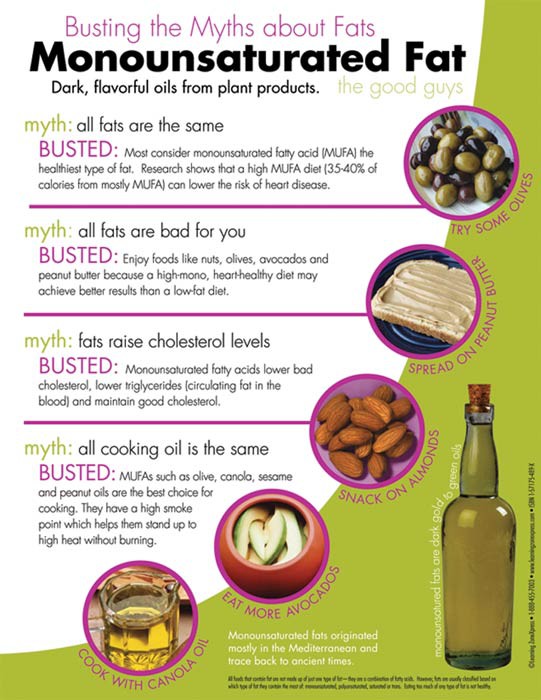Dietary fats: Myths and truths; Best and worst!
Are you still confused about the “best” and “worst” fats? Are low-fat diets best for weight loss? Or is that old news?
Myths
“Fats” is not a four-letter word signifying obesity; fats are essential components of a healthy diet. However, all fats are not equal in terms of health, and in fact, eating too much of one type of oil has shown to be downright unhealthy.
components of a healthy diet. However, all fats are not equal in terms of health, and in fact, eating too much of one type of oil has shown to be downright unhealthy.
Although dietary fat has double the calories per gram of carbohydrate and protein (fat – 9 calories per gram; carbohydrate and protein – 4 calories per gram), eating fat won’t make you fat. Eating too much fat will make you fat — and so will eating too many calories from carbohydrate and from protein too. Excessive calories from any macronutrient source will make you fat.
A very low fat diet can have health consequences, especially when you replace healthy fats with refined carbohydrates. In the 1980s, when low-fat diets and fat-free foods were the craze, manufacturers replaced fat with sugar in many cookies, cakes, yogurts and cream cheese to make up for the texture that fat naturally brings to foods. Accordingly, people flocked to unhealthy processed foods, thought they could eat more, and obesity rates have exploded.
Truths
 Fat has many functions, and the primary one is as an energy reserve — we’re born with the ability to take foods and convert them to energy, and to fat — to store in our adipose tissue. Dietary fats are necessary for hormonal production and health, to help the body absorb certain “fat soluble” vitamins including vitamins A, D, E, and K. Fat insulates us, protects organs, and is essential for skin and hair health. Fat also brings taste to food. A fat-free diet is a recipe for boredom.
Fat has many functions, and the primary one is as an energy reserve — we’re born with the ability to take foods and convert them to energy, and to fat — to store in our adipose tissue. Dietary fats are necessary for hormonal production and health, to help the body absorb certain “fat soluble” vitamins including vitamins A, D, E, and K. Fat insulates us, protects organs, and is essential for skin and hair health. Fat also brings taste to food. A fat-free diet is a recipe for boredom.
There are different types of fats:
Saturated fat is solid at room temperature, and includes animal fats like butter, lard, and cheese. Some plant fats are also saturated, including the most highly saturated fat, coconut oil, and palm oil and palm kernel oil.
Monounsaturated fats are liquid at room temperature, and good sources include olive oil, canola oil, and peanut oil, avocados and most nuts, plus high-oleic safflower oil and sunflower oils.
Polyunsaturated fats are also liquid at room temperature, and are essential fats plant oils — the body is able to produce mono – and – saturated fats, but two essential fatty acids, linoleic and alpha-linolenic, cannot be synthesized in the body and must be obtained in plant foods. As reported by the Physicians Committee for Responsible Medicine (PCRM), these essential fatty acids are used to build omega-3 and omega-6 fatty acids and, … Omega-3 and omega-6 fatty acids are important in the normal functioning of all tissues of the body.
Article continues below graphic.
 Deficiencies in these fatty acids lead to a host of symptoms and disorders including abnormalities in the liver and the kidneys, reduced growth rates, decreased immune function, depression, and dryness of the skin. Adequate intake of the essential fatty acids results in numerous health benefits. Documented benefits include prevention of atherosclerosis, reduced incidence of heart disease and stroke, and relief from the symptoms associated with ulcerative colitis, menstrual pain, and joint pain. Omega-3 fatty acid levels have also been associated with decreased breast cancer risk.
Deficiencies in these fatty acids lead to a host of symptoms and disorders including abnormalities in the liver and the kidneys, reduced growth rates, decreased immune function, depression, and dryness of the skin. Adequate intake of the essential fatty acids results in numerous health benefits. Documented benefits include prevention of atherosclerosis, reduced incidence of heart disease and stroke, and relief from the symptoms associated with ulcerative colitis, menstrual pain, and joint pain. Omega-3 fatty acid levels have also been associated with decreased breast cancer risk.
Sources of omega-3 and omega-6 fatty acids:
Omega-3s: Most fatty fish provide a good amount of omega-3 fatty acids, including salmon, tuna, herring, mackerel, and trout.
Omega-6s: most omega-6 fats are derived from linoleic acid, from green leafy vegetables, seeds, nuts, grains, and vegetables oils including corn, safflower, soybean, cottonseed, sesame, and sunflower. Most people have no problem consuming adequate amounts of omega-6 fatty acids.
Worst Oils
All mercados are crammed with highly refined and processed corn, soybean, canola, safflower, and sunflower oils — and the catchall “vegetable oil.” Most are chemically processed, deodorized, and so are shelf-stable for a long, long time. Just about every processed food, including salad dressings, mayonnaise, baked goods, crackers, baby food, everything is made with these cheap oils.
And they’re very high in omega-6 fatty acids, which health experts say creates an imbalance linked to inflammation.
 Today’s Western diet has changed the balance from a recommended 1:1 ratio of omega-3 fatty acids to omega-6 fatty acids to about 16:1. This imbalance in favor of omega-6 fatty acids may be inflammatory and could be linked and increased rate of associated diseases including type 2 diabetes, certain cancers, and even Alzheimer’s disease.
Today’s Western diet has changed the balance from a recommended 1:1 ratio of omega-3 fatty acids to omega-6 fatty acids to about 16:1. This imbalance in favor of omega-6 fatty acids may be inflammatory and could be linked and increased rate of associated diseases including type 2 diabetes, certain cancers, and even Alzheimer’s disease.
The European Food Information Council says we should be concerned with the absolute levels of intake. Translation? Cut back on omega-6-rich processed vegetable oils and boost your omega-3s.
As mentioned, fish highest in omega-3 fatty acids include salmon, tuna, trout, mackerel, sardines, and herring. Eat a variety of (not deep-fried) fish at least twice a week and vary your fish choices. Large predator fish are more like to contain higher levels of mercury, and farmed fish may be fed antibiotics, so eating wild-caught fish is your best bet, and smaller fish are safest. Occasionally eat some big fish, and check out the Environmental Defense Fund’s recommended varieties here.
The PCRM advises that omega-3s are found in a more stable form than fish — in ALA, or alpha-linolenic acid, which the body converts into eicosapentaenoic acid (EPA) and docosahexaenoic acid (DHA) by the body. Ground flaxseed and flaxseed oil are especially rich sources. PCRM writes that one-teaspoon of flaxseed oil or a tablespoon of ground flaxseed will supply the daily requirement of alpha-linolenic acid. Whole flaxseeds won’t cut it. Flaxseed must be ground in order for you to absorb the nutrients, and heat will damage the omega-3s in flaxseed oil, so don’t heat it, and store in the refrigerator to prevent oxidative damage. Other plant sources of omega-3s include walnut, canola and soybean oils, and walnuts and soybeans.
Article continues below graphic.
 How to find the healthiest oils?
How to find the healthiest oils?
Only a few manufacturers market 100% pure unrefined oils, extracted using cold pressed method.
The Olive Oil Times suggests that it’s very difficult to know which brands marked “extra virgin” are really virgin! Don’t rely on the “refrigerator test” to assess the best oil — some say oil should solidify if it’s real; others say it should not solidify if it’s real! There are many natural factors that affect an oil’s makeup, including the olive variety, seasonal growing conditions, the latitude of the country of origin, the time of harvest, and the processing methods.
The Olive Oil Times suggests looking for quality seals on the bottles, such as from the California Olive Oil Council, and checking the harvest date on the bottle, buying only oil that has been harvested in the past 15 months. If there’s no indication of a harvest date, don’t buy it.
A colleague and friend suggests the Mallorca Extra Virgin Olive Oil, available at Supermaxi. What is your favorite brand? Where do you buy cold-pressed, “virgin” oils in Cuenca? Please share your sources and reviews in the Comments below.
Sources
Environmental Defense Fund. EDF Seafood Selector
http://seafood.edf.org/guide/best
European Food Information Council. The importance of omega-3 and omega-6 fatty acids. https://www.livescience.com/9109-fats-body.html
LiveScience.com. What Is Dietary Fat? https://www.livescience.com/53145-dietary-fat.html
LiveScience.com. What Do Fats Do in the Body? https://www.livescience.com/9109-fats-body.html
Olive Oil Times. Olive Oil Fridge Test? Don’t Count On It. https://www.oliveoiltimes.com/olive-oil-basics/olive-oil-fridge-test/32830
Physicians Committee for Responsible Medicine. Essential Fatty Acids. http://www.pcrm.org/health/health-topics/essential-fatty-acids





















